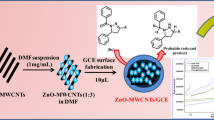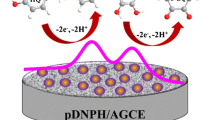Abstract
Multiwalled carbon nanotubes (MWCNT) were covered with reduced graphene oxide nanoribbons (rGONR) to give a material with a core-shell heterostructure of the type MWCNT@rGONR. It was obtained by (a) longitudinal partial unzip** of MWCNT to form MWCNT@GONR, and (b) subsequent chemical reduction with hydrazine to give MWCNT@rGONR. The MWCNT@rGONR heterostructure was used to modify a glassy carbon electrode (GCE) to obtain an electrochemical sensor for p-dihydroxybenzene (DHB). The synergistic effects of the MWCNT and the rGONR results in a distinctly improved redox current towards DHB compared to a bare GCE, an MWCNT/GCE, and an MWCNT@GONR/GCE. At the working voltage range from −100 to 400 mV, it displays a linear response to DHB in the 80 to 3000 nM concentration range with a 20 nM detection limit.

Multiwalled carbon nanotubes covered with reduced graphene oxide nanoribbons (MWCNT@rGONR) core-shell heterostructure was obtained by longitudinal partial unzip** of MWCNT and subsequent chemical reduction. The MWCNT@rGONRs were used for highly sensitive electrochemical sensing of p-dihydroxybenzene.









Similar content being viewed by others
References
Wang H-F, Wu Y-Y, Yan X-P (2013) Room-temperature phosphorescent discrimination of catechol from resorcinol and hydroquinone based on sodium tripolyphosphate capped Mn-doped ZnS quantum dots. Anal Chem 85:1920–1925
Tang W, Zhang M, Li W, Zeng X (2014) An electrochemical sensor based on polyaniline for monitoring hydroquinone and its damage on DNA. Talanta 127:262–268
Vyskocil V, Barek J (2011) Electroanalysis of nitro and amino derivatives of polycyclic aromatic hydrocarbons. Curr Org Chem 15:3059–3076
Ponnusamy VK, Jen J (2011) A novel graphene nanosheets coated stainless steel fiber for microwave assisted headspace solid phase microextraction of organochlorine pesticides in aqueous samples followed by gas chromatography with electron capture detection. J Chromatogr A 1218:6861–6868
Judefeind A, van Rensburg PJ, Langelaar S, du Plessis J (2007) Stable isotope dilution analysis of salicylic acid and hydroquinone in human skin samples by gas chromatography with mass spectrometric detection. J Chromatogr B 852:300–307
Satonin DK, McCulloch JD, Kuo F, Knadler MP (2007) Development and validation of a liquid chromatography—tandem mass spectrometric method for the determination of the major metabolites of duloxetine in human plasma. J Chromatogr B 852:582–589
Gao W, Legido-Quigley C (2011) Fast and sensitive high performance liquid chromatography analysis of cosmetic creams for hydroquinone, phenol and six preservatives. J Chromatogr A 1218:4307–4311
Feng X, Gao W, Zhou S, Shi H, Huang H, Song W (2013) Discrimination and simultaneous determination of hydroquinone and catechol by tunable polymerization of imidazolium-based ionic liquid on multi-walled carbon nanotube surfaces. Anal Chim Acta 805:36–44
Zhu G, Gai P, Wu L, Zhang J, Zhang X, Chen J (2012) b-Cyclodextrin-platinum nanoparticles/graphene nanohybrids: enhanced sensitivity for electrochemical detection of naphthol isomers. Chem Asian J 7:732–737
Canevari TC, Arenas LT, Landers R, Custodio R, Gushikem Y (2013) Simultaneous electroanalytical determination of hydroquinone and catechol in the presence of resorcinol at an SiO2/C electrode spin-coated with a thin film of Nb2O5. Analyst 138:315–324
Tang L, Zhou Y, Zeng G, Li Z, Liu Y, Zhang Y, Chen G, Yang G, Lei X, Wu M (2013) A tyrosinase biosensor based on ordered mesoporous carbon–Au/l-lysine/Au nanoparticles for simultaneous determination of hydroquinone and catechol. Analyst 138:3552–3560
Unnikrishnan B, Ru P-L, Chen S-M (2012) Electrochemically synthesized Pt–MnO2 composite particles for simultaneous determination of catechol and hydroquinone. Sens Actuators B 169:235–242
Kim KH, Oh Y, Islam M (2012) Graphene coating makes carbon nanotube aerogels superelastic and resistant to fatigue. Nat Nano 7:562–566
Wang X d, Meier RJ, Wolfbeis OS (2013) Fluorescent pH-sensitive nanoparticles in an agarose matrix for imaging of bacterial growth and metabolism. Angew Chem 125:424–427
Kochmann S, Baleizão C, Berberan-Santos M r N, Wolfbeis OS (2013) Sensing and imaging of oxygen with parts per billion limits of detection and based on the quenching of the delayed fluorescence of 13C70 fullerene in polymer hosts. Anal Chem 85:1300–1304
Sanghavi B J, Wolfbeis O S, Hirsch T, Swami N S (2014) Nanomaterial-based electrochemical sensing of neurological drugs and neurotransmitters. Microchim Acta 1–41
Peng L, Feng Y, Lv P, Lei D, Shen Y, Li Y, Feng W (2012) Transparent, conductive, and flexible multiwalled carbon nanotube/graphene hybrid electrodes with two three-dimensional microstructures. J Phys Chem C 116:4970–4978
Byon HR, Gallant BM, Lee SW, Shao-Horn Y (2013) Role of oxygen functional groups in carbon nanotube/graphene freestanding electrodes for high performance lithium batteries. Adv Funct Mater 23:1037–1045
Liang J, Yang S, Luo S, Liu C, Tang Y (2014) Ultrasensitive electrochemiluminescent detection of pentachlorophenol using a multiple amplification strategy based on a hybrid material made from quantum dots, graphene, and carbon nanotubes. Microchim Acta 181:759–765
Lu Z, Yang S, Yang Q, Luo S, Liu C, Tang Y (2013) A glassy carbon electrode modified with graphene, gold nanoparticles and chitosan for ultrasensitive determination of lead (II). Microchim Acta 180:555–562
Jiao L, Zhang L, Wang X, Diankov G, Dai H (2009) Narrow graphene nanoribbons from carbon nanotubes. Nature 458:877–880
Lin J, Peng Z, **ang C, Ruan G, Yan Z, Natelson D, Tour JM (2013) Graphene nanoribbon and nanostructured SnO2 composite anodes for lithium ion batteries. ACS Nano 7:6001–6006
Li X, Wang X, Zhang L, Lee S, Dai H (2008) Chemically derived, ultrasmooth graphene nanoribbon semiconductors. Science 319:1229–1232
Liu M, Miao Y-E, Zhang C, Tjiu WW, Yang Z, Peng H, Liu T (2013) Hierarchical composites of polyaniline-graphene nanoribbons-carbon nanotubes as electrode materials in all-solid-state supercapacitors. Nanoscale 5:7312–7320
Martin-Fernandez I, Wang D, Zhang Y (2012) Direct growth of graphene nanoribbons for large-scale device fabrication. Nano Lett 12:6175–6179
Osella S, Narita A, Schwab MG, Hernandez Y, Feng X, Müllen K, Beljonne D (2012) Graphene nanoribbons as low band gap donor materials for organic photovoltaics: quantum chemical aided design. ACS Nano 6:5539–5548
Liao L, Bai J, Lin Y-C, Qu Y, Huang Y, Duan X (2010) High-performance top-gated graphene-nanoribbon transistors using zirconium oxide nanowires as high-dielectric-constant gate dielectrics. Adv Mater 22:1941–1945
Wei D, ** for intramolecular junctions of graphene nanoribbons and single-walled carbon nanotubes. Nat Commun 4:1374
Kosynkin DV, Higginbotham AL, Sinitskii A, Lomeda JR, Dimiev A, Price BK, Tour JM (2009) Longitudinal unzip** of carbon nanotubes to form graphene nanoribbons. Nature 458:872–876
Li Y, Zhou W, Wang H, **e L, Liang Y, Wei F, Idrobo J-C, Pennycook SJ, Dai H (2012) An oxygen reduction electrocatalyst based on carbon nanotube-graphene complexes. Nat Nano 7:394–400
Shinde DB, Debgupta J, Kushwaha A, Aslam M, Pillai VK (2011) Electrochemical unzip** of multi-walled carbon nanotubes for facile synthesis of high-quality graphene nanoribbons. J Am Chem Soc 133:4168–4171
Wang H, Wang Y, Hu Z, Wang X (2012) Cutting and unzip** multiwalled carbon nanotubes into curved graphene nanosheets and their enhanced supercapacitor performance. ACS Appl Mater Interfaces 4:6827–6834
Yu D, Dai L (2009) Self-assembled graphene/carbon nanotube hybrid films for supercapacitors. J Phys Chem Lett 1:467–470
Wu S, Lan X, Huang F, Luo Z, Ju H, Meng C, Duan C (2012) Selective electrochemical detection of cysteine in complex serum by graphene nanoribbon. Biosens Bioelectron 32:293–296
Alpert AJ (2007) Electrostatic repulsion hydrophilic interaction chromatography for isocratic separation of charged solutes and selective isolation of phosphopeptides. Anal Chem 80:62–76
Wang L, Hua E, Liang M, Ma C, Liu Z, Sheng S, Liu M, **e G, Feng W (2014) Graphene sheets, polyaniline and AuNPs based DNA sensor for electrochemical determination of BCR/ABL fusion gene with functional hairpin probe. Biosens Bioelectron 51:201–207
Acknowledgments
This work was supported by the National Natural Science Foundation of China (21405062), the China Postdoctoral Science Foundation (2014 M551507, 2014 M550271), Scientific Research Foundation for the Talents in Jiangsu University (13JDG091), Jiangsu Planned Projects for Postdoctoral Research Funds (2014).
Author information
Authors and Affiliations
Corresponding author
Electronic supplementary material
Below is the link to the electronic supplementary material.
ESM 1
(PDF 266 kb)
Rights and permissions
About this article
Cite this article
Zhu, G., Yi, Y., Zou, B. et al. A glassy carbon electrode modified with a multiwalled carbon nanotube@reduced graphene oxide nanoribbon core-shell structure for electrochemical sensing of p-dihydroxybenzene. Microchim Acta 182, 871–877 (2015). https://doi.org/10.1007/s00604-014-1401-8
Received:
Accepted:
Published:
Issue Date:
DOI: https://doi.org/10.1007/s00604-014-1401-8




